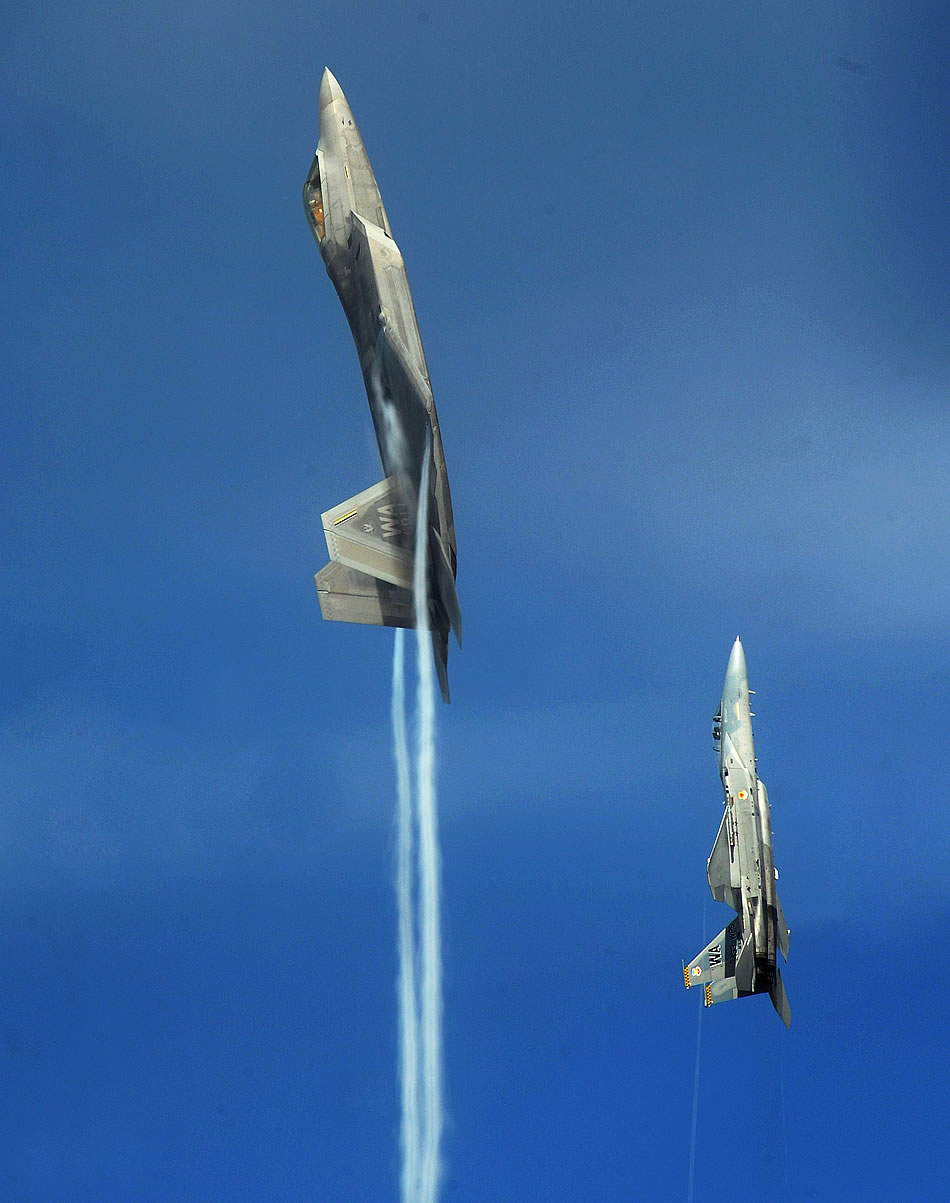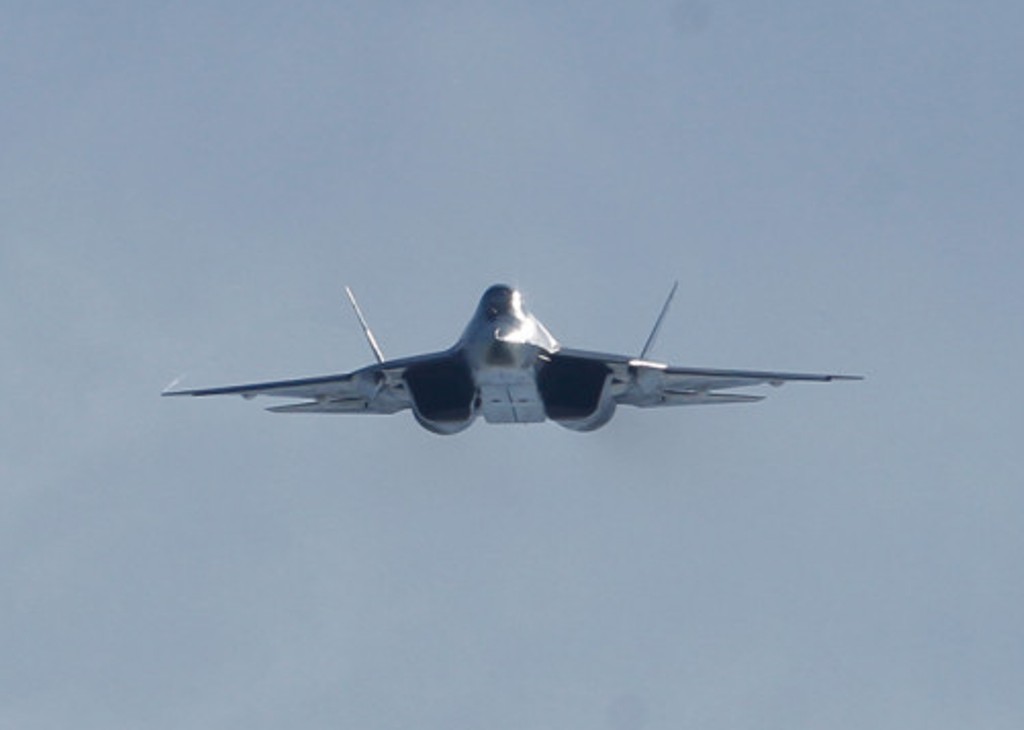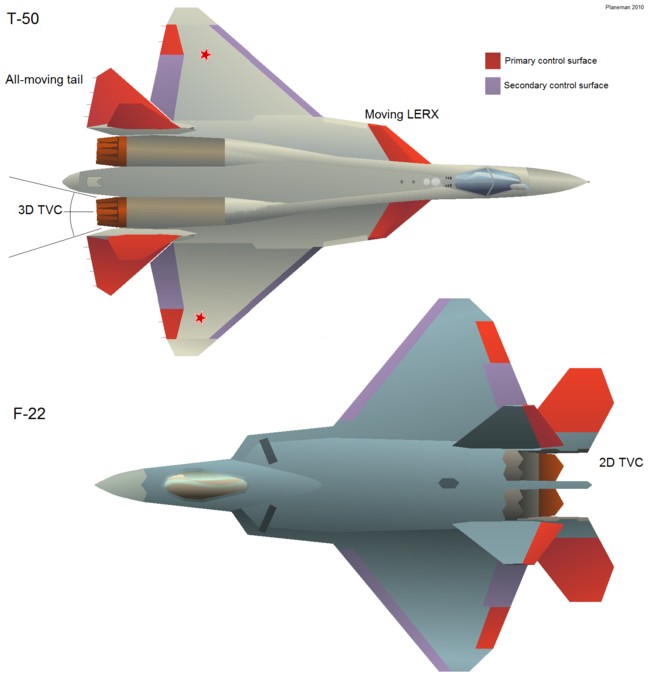Fighter jets like the F-16, F-15, etc. have wings smaller than the length of the fuselage and can perform great maneuvers very quickly while an airliner with a long wingspan takes a lot of time to perform these kind of maneuvers. How does a short wingspan on a fighter jet perform such great maneuvers?
-
2$\begingroup$ Some fighter jets have a long winspan. The ones I am reffering too are the f15,f16,f18, and the f35. $\endgroup$– EthanCommented Sep 16, 2015 at 13:09
-
$\begingroup$ Jet fighters have low aspect ratio wings. Their wing area is not as small as you'd think from just looking at wing span. Even so, they get by with small wings. See my answer, and en.wikipedia.org/wiki/Aspect_ratio_%28aeronautics%29. $\endgroup$– Peter CordesCommented Sep 16, 2015 at 18:28
-
$\begingroup$ Fighters have actually larger wings than airliners - when compared to their mass (smaller wing loading). $\endgroup$– Agent_LCommented Sep 17, 2015 at 10:10
-
1$\begingroup$ "If I were meant to fly at speed, I'd have a falcon's short wings, and live on mice instead of fish." -- Jonathon Livingston Seagull, Richard Bach $\endgroup$– Ross PresserCommented Sep 18, 2015 at 6:13
7 Answers
Fighter (combat) aircraft are designed to perform quick maneuvers in order to get into a position quickly to engage and shoot down an enemy aircraft or evade incoming threats (like missiles, etc.). Civil aircraft like airliners are designed with other things in mind like comfort, safety, reduced fuel consumption, etc.
The wings are only a part of the story in performing maneuvers like those performed in air combat maneuvering, which depends on a number of aircraft characteristics like,
Power - For carrying out most of the maneuvers (like wingover), the excess power available matters. Fighter aircraft have more excess power, which translates into more acceleration. That allows it it enter into maneuvers quickly compared to the civil aircraft. In case of emergencies, the combat aircraft can use their afterburners to gain significant extra power.
Thrust-to-Weight Ratio - Most of the modern fighters have high thrust-to-weight ratios, usually more than 1 (which allows them to accelerate in vertical climb). This allows the fighters to accelerate far faster compared to the civil aircraft. For example, F-15 (>1) had a thrust-to-weight ratio more the three times that of the Concorde (~0.33).
Source: strategypage.com
Stability Most of the fighter aircraft today are designed to be unstable. This makes the aircraft respond to control inputs much more quickly compared to the airliners (which are usually not unstable in the roll axis). This means that the combat aircraft are capable of maneuvering much more quickly.
Inertia In case of large wings, the roll inertia is very high. This prevents them from performing quick maneuvers. Also, the damping of the large wings is also to be considered. In case of fighters, however, the short wings, having smaller inertia helps in achieving high roll rates.
Wing Loading The smaller the wing loading, the better the turn performance. Most of the combat aircraft employ a blended wing-fuselage design, that reduces the load on the wings. For example, the Eurofighter Typhoon (~300 kg/$m^{2}$) has about half the wing loading of A380 (>600 kg/$m^{2}$). In fact, an F-15 produced enough lift with half a wing gone to perform a successful landing.
Source:www.armchairgeneral.com
- Control Surfaces- In general, the combat aircraft have more number of control surfaces like canards (in addition to primary control surfaces) compared to the civil aircraft. This enables the pilot to maneuver the aircraft much more quickly compared to airliners.
Source: www.blokeish.com
Due to these reasons, the fighter aircraft are able to perform maneuvers much better and faster compared to airliners.
-
6$\begingroup$ Re the instability: it may be worth noting that in a lot of fighter jets, the instability is so great that you have to constantly make micro-adjustments just to maintain level flight -- whereas non-fighter planes are often stable enough that if you just let go, they pretty much stay where they're going. These micro-adjustments are why fighter planes have to be fly-by-wire; a human could never make them fast or precisely enough. The F-16 was the first production plane to use this system. $\endgroup$– yshavitCommented Sep 16, 2015 at 15:32
-
5$\begingroup$ No answer mentions it, but the vectored thrust helps too. $\endgroup$– minsCommented Sep 16, 2015 at 15:46
-
$\begingroup$ Yeah mins; I was looking through the comments to find this. It allows the plane to change the angle of its exhaust. Here is the wiki link en.wikipedia.org/wiki/Thrust_vectoring $\endgroup$– user001Commented Sep 17, 2015 at 7:48
-
2$\begingroup$ Can anyone comment on what 2D versus 3D TVC (Thrust Vector Control ?) means in the last figure? Being a nitpicking scientist type, I would think it is either 1D (just up/down or just left/right) or 2D (both up/down and left/right). I don't understand how you can get 3D. $\endgroup$ Commented Sep 17, 2015 at 9:14
-
2$\begingroup$ @yshavit : Indeed. Just an example of the opposite extreme: I once piloted a German glider which had the instruction for most of the emergency cases, including stall and spin, to just let go of all controls and wait for the aircraft to automatically resume level flight. This was solved purely mechanically, by making the aircraft so stable that it was extremely hard to enter into a spin even intentionally. $\endgroup$– vszCommented Sep 17, 2015 at 20:31
Wingspan and maneuverability are not necessarily closely linked. Important factors that affect maneuverability are mass and thrust, which can be combined into a thrust to weight ratio, and also wing loading, which does relate to the size of the wings.
The thrust to weight ratio of a 737-500 is around 0.32, for an F-15 it can exceed 1.1, which is a huge difference (larger is better).
An F-15 has a nominal wing loading of 358 kg/m², compared with 497.05 for a 737-500 (lower is better).
The combined effect of increased thrust to weight ratio and reduced wing loading means a fighter jet is a very different kind of plane from a passenger liner.
Finally, regarding wing loading, on many fighter jets starting in the 1970s, the body also partly acts as part of the wing area. Notice that modern fighter fuselages do not have the cylindrical or ellipsoidal cross-sections that you see on a passenger liner. This design style further separates wingspan from maneuverability.
Fighters and aerobatic aircraft have large control surfaces (ailerons, elevators, rudders, elvons, stabilators, etc) as it is control surfaces and not the wings themselves which cause the attitude changes which maneuver the airplane.
-
$\begingroup$ To be most clear, fighters have larger control surfaces relative to their overall mass and cross-sectional areas. It is possible to have absolutely smaller control surfaces that are more effective than larger ones because of the relationship to the rest of the plane. $\endgroup$ Commented Sep 16, 2015 at 14:12
-
1$\begingroup$ Changing attitude is only one part of the story. If your wings don't provide enough lift to change your direction, changing attitude without changing direction leads to stalling. See my answer. $\endgroup$ Commented Sep 16, 2015 at 18:06
Wingspan and maneuverability are definitely not related. Thrust to weight ratio and wing loading plays a vital role.
Traditional aircraft maneuvering is accomplished by altering the flow of air passing over the control surfaces of the aircraft—the ailerons, elevators, flaps, air brakes and rudder.
Here is a picture of supermaneuverability of a jet fighter:
Supermaneuverability is the ability of aircraft to have control and do maneuvers in situations and in the ways exceeding that which is possible by pure aerodynamic mechanisms. This ability was first introduced in the Russian Sukhoi Su-27 and Mikoyan MiG-29 fighter aircraft in the 1980s, which has since become a standard in their advanced 4th and 5th generation aircraft.
-
3$\begingroup$ Ah, the Cobra. No discussion of airplane maneuverability is complete without it! $\endgroup$ Commented Sep 16, 2015 at 19:07
-
1$\begingroup$ It only shows that fighters are agile, but this answer fails to answer why. It does state that "wing loading" is important without stating anything about wing loading differences, or even what is good. $\endgroup$– MSaltersCommented Sep 17, 2015 at 14:17
Lift is proportional to wing area, not just wingspan.
Fighter jets typically have narrow wings (as you noted), but they run most of the length of the fuselage (low aspect ratio). Larger slower-moving planes typically have long skinny wings.
Low aspect ratio wings are usually used on fighter aircraft, not only for the higher roll rates, but especially for longer chord and thinner airfoils involved in supersonic flight.
-- wikipedia's Aspect Ratio article
Many jet fighters, esp. the F15 as noted in several answer, generate lift from the fuselage, significantly increasing effective wing area. The entire wingtip-to-wingtip span is wing, because there's no non-wing fuselage in the middle.
So even though the premise of the question is somewhat flawed, there are reasons:
I'm not sure if fighter jets have more or less wing area per mass than larger craft. It's reasonable to assume they have less area per nose-to-tail length, though, because mass increases with the size3, while surface area increases with size2.
Compared to a big plane, 1/2 length -> 1/8th mass, requiring only 1/8th wing surface area, not the 1/4 area you'd have from a proportional scale-model.
To turn, you need to get the entire mass of the plane moving in a different direction. To pull into a loop, you not only need to change attitude quickly (large control surfaces); you also need lift from the increased angle of attack to change the plane's motion vector. (With large control surfaces but not enough lift, you pitch up but keep moving horizontally, and stall).
"Enough lift" depends on the mass of the plane, because $F = m a$. Keeping proportions the same, a larger plane would have less lift per mass, because of the cube vs square issue.
Another important factor is speed. The faster a plane is moving, the more extra lift for you gain from pitching up. The faster you're going, the more air you can push on per wing area. At high speed, you don't need as much wing area to produce the max ~9G of acceleration a pilot can handle.
In terms of turning-radius, this is more than cancelled out by the centripetal force needed for a constant-radius turn increasing quadratically with speed. (Thanks @Todd for catching this). Degrees-per-second (angular velocity, ω) is similarly not helped by moving faster, once you're going fast enough to make a max-G-force manoeuvre.
F = lift-factor * v = ma.
$m \omega^2 r = mv^2/r = F$
$\omega^2 r = v^2/r = F/m = a = 9G$
$\omega^2 = v^2 / r^2$
$\omega = v/r$. But for constant $a$, $r$ is proportional to $v^2$.
$\omega = v / (v^2/a) = a/v$ (where $a$ is constant)
So at speeds fast enough for max acceleration to be the limiting factor, turn rate ~= 1/v. At lower speeds, where achievable $a$ increases ~linearly with speed, ω is about the same at any speed up to $a = 9G$. High thrust is needed to overcome the high drag of high lift / high angle-of-attack turning.
Small planes also make it easier to make wings strong enough to not snap them off at a high angle of attack (difference between heading and facing, whether it's in the vertical plane, or turning horizontally after rolling to near 90 degrees.) Low aspect ratio wings spread the load over a longer attachment point with the fuselage, helping with this.
In a high angle-of-attack, the engines are contributing some of the necessary centripetal force to bend the plane's momentum vector, because they're pushing the plane in the new direction, not just along its current trajectory.
So combining all these factors, fighter jets get a lot out of their wings by moving fast, having sturdy wings that can take high loads, and by being light so the wings don't have as much mass to turn.
Appropriately sized control surfaces are obviously a requirement, to hold a figher jet in a high-angle-of-attack turn.
I think vectored thrust contributes mostly in this area. In a (non-inverted) loop, a jet would have its thrust vectored upward, along with the elevators, pushing the tail down. This means less thrust is contributing to centripetal force; instead it's helping to hold the plane in a higher angle of attack so the wings can pull the plane in a tighter loop.
I'm sure there are some mistakes here, since I don't actually design airplanes, or even fly them outside of video games. I'm just applying simple physics and making stuff up. It looks like a lot of what I said is pretty much what wing loading is.
-
1$\begingroup$ "The faster a plane is moving, the more extra lift for you gain from pitching up. The faster you're going, the more air you can push on with the same size wings." But also the more extra lift you need since you have more momentum for the same mass. Force grants change in momentum, and the other side of that is greater changes in momentum require greater force. This is why there is a corner velocity below the maximum speed of the plane instead of faster always being better. $\endgroup$ Commented Sep 16, 2015 at 19:00
-
$\begingroup$ @ToddWilcox: Good catch. Updated my answer (which now probably spends too much time on the math there...). Maximum acceleration is limited to about 9G, and at high speed you don't need as much wing area to produce that much lift. That's what I meant to say before, not actually that you can turn faster if you're going faster. $\endgroup$ Commented Sep 16, 2015 at 19:49
Acceleration = force/mass
Fighters have greater accelration (whether linear or rotational), because their force-to-mass ratio is greater than for an airliner. Simple physics.
For a rotational acceleration, moment of inertia takes the place of mass in the above equation. Shorter wings reduce the moment of inertia.
-
1$\begingroup$
shorter wings reduce the moment of inertianot only, they also give much less rotational damping. moment of inertia will slow down the acceleration and the damping will slow down the rotation. $\endgroup$– FedericoCommented Sep 16, 2015 at 13:35 -
$\begingroup$ "For a rotational acceleration, moment of inertia takes the place of mass in the above equation" and force is replaced by torque. "Shorter wings reduce the moment of inertia" and also the potential torque from having a control surface at greater distance from the axis of rotation. It's not immediately obvious that these two competing factors resolve in a direction that increases, rather than decreases, acceleration. $\endgroup$ Commented Sep 16, 2015 at 17:05
-
$\begingroup$ @DavidRicherby For for given accereation rate (linear or rotational), less force (torque) is required for an object with a lesser mass (moment of inertia). Sure, the fighter's aileron may be creating less overall torque (due to a lesser arm and surface area), and if it is, then the MOI MUST be soooooo much lower than the airliner's that it results in an overall greater acceleration. $\endgroup$– Steve HCommented Sep 16, 2015 at 20:16
-
$\begingroup$ @SteveH Sure but now things are backwards. You're deducing the physics from the behaviour of the aircraft (the fighter is more manoeuvrable so the MOI must decrease more than the torque), wereas you're supposed to be using the physics to explain the behaviour. $\endgroup$ Commented Sep 16, 2015 at 20:24
In the glider community it's been known since the early ages that a longer wingspan decreases maneuverability: gliders with a larger wingspan are more "lazy" with the ailerons.
Of course it is not the only factor, and as wing design has evolved into more sophisticated airfoils, the effect is less noticeable than it used to be in the past.
-
1$\begingroup$ I can't believe this hasn't gotten an upvote in almost 8 years! There are some better answers, but this is the very first thing that came to my mind when I read the question, and I don't think any of the other answers give it enough credit. Sheer physical size is a major contributor. Consider an RC model of an airliner, it will be much more "snappy" than the real thing. $\endgroup$ Commented Aug 4, 2023 at 18:18




